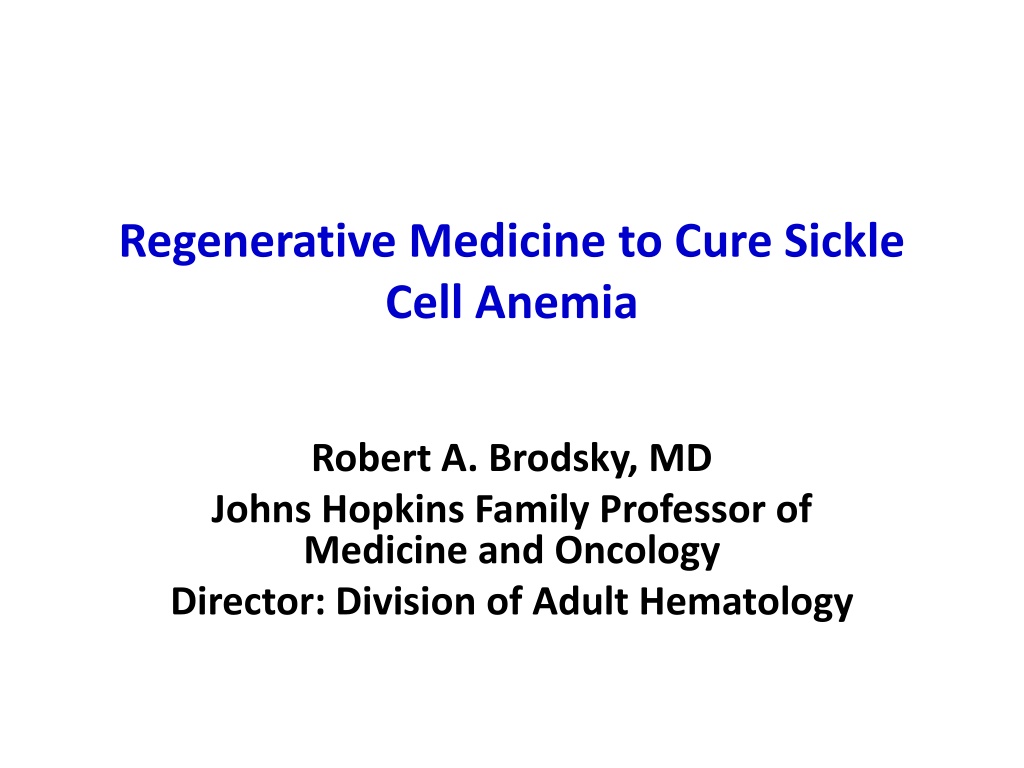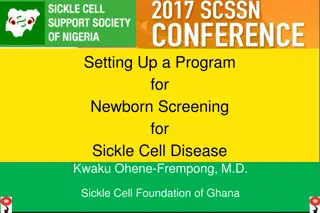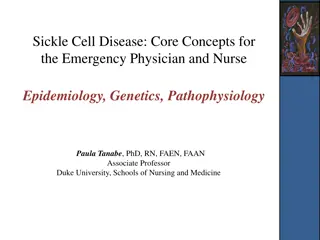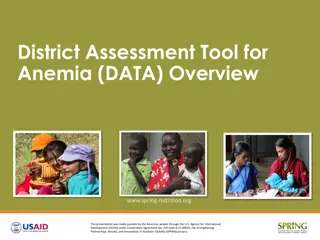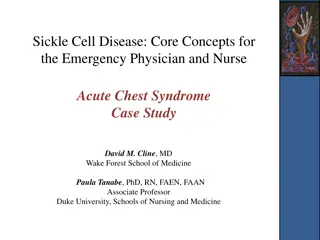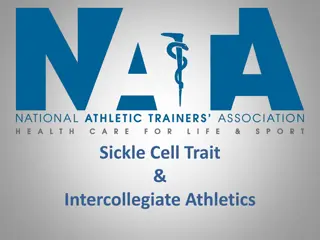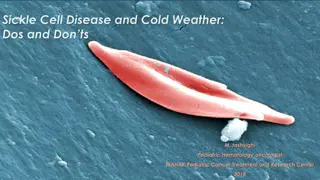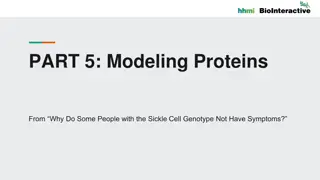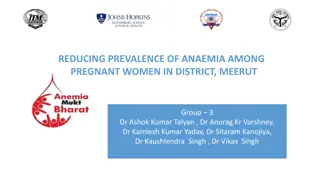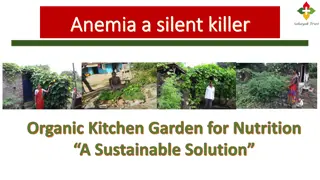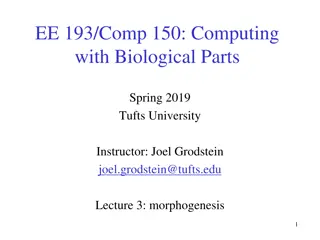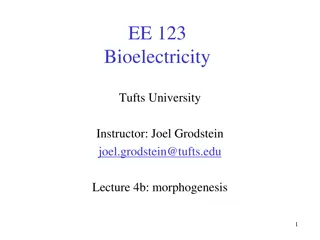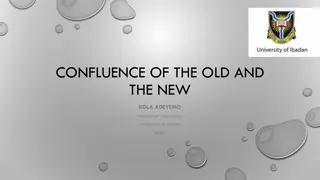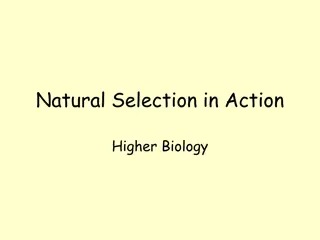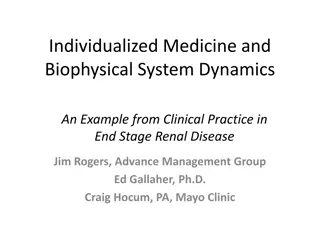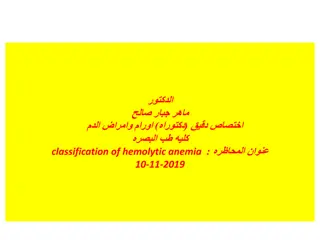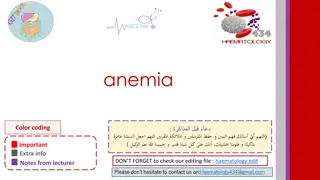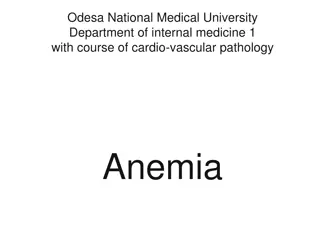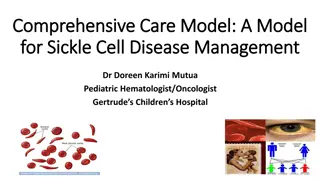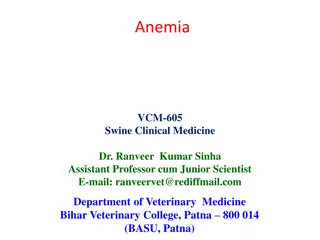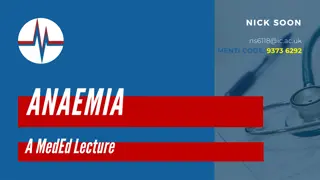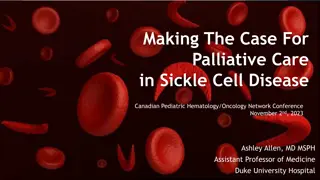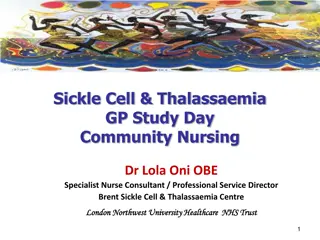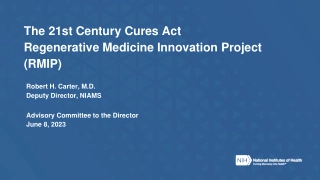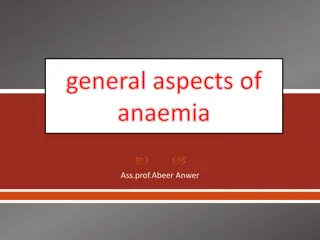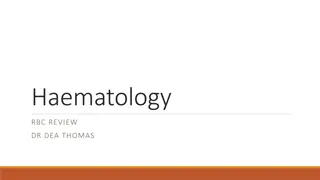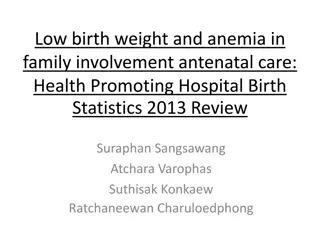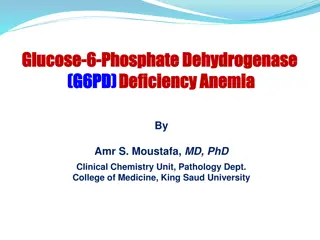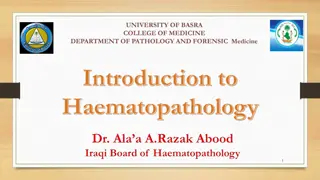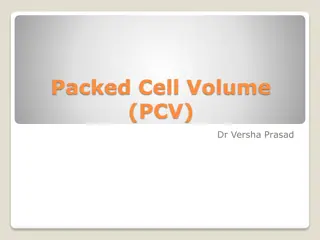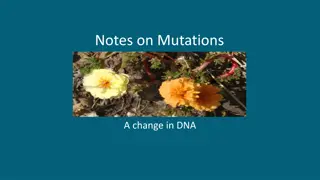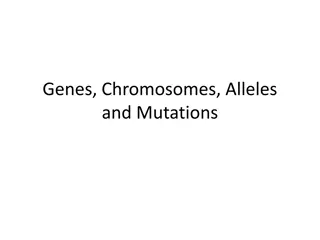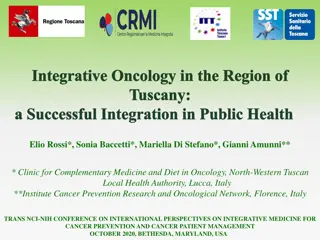Advancements in Regenerative Medicine for Sickle Cell Anemia
Regenerative medicine holds promise for treating sickle cell anemia through techniques like stem cell transplantation. This approach targets genetic blood diseases, offering potential cures beyond traditional uses like eradicating cancer. Despite obstacles like toxicity and donor availability, innovative methods like reduced intensity BMT show potential benefits, including lower toxicity and outpatient procedures.
- Regenerative Medicine
- Sickle Cell Anemia
- Stem Cell Transplantation
- Genetic Blood Diseases
- Advancements
Download Presentation

Please find below an Image/Link to download the presentation.
The content on the website is provided AS IS for your information and personal use only. It may not be sold, licensed, or shared on other websites without obtaining consent from the author. Download presentation by click this link. If you encounter any issues during the download, it is possible that the publisher has removed the file from their server.
E N D
Presentation Transcript
Regenerative Medicine to Cure Sickle Cell Anemia Robert A. Brodsky, MD Johns Hopkins Family Professor of Medicine and Oncology Director: Division of Adult Hematology
Glossary of terms BMT Bone marrow transplantation Blood or marrow transplantation Stem cell transplantation Hematopoietic cell transplantation Peripheral blood stem cell transplantation Synonyms Donor Syngeneic identical twin Autologous self (blood or bone marrow) Allogeneic another of same species Matched sibling Alternative Donor Matched unrelated donor (MUD) Non-matched sibling (haplo identical) Cord Blood HES or iPSC (not yet feasible)
Glossary continued: Conditioning regimen Myeloablative Conditioning without BMT would lead to permanent aplasia Non-myeloablative aka miniBMT, reduced intensity Autologous recovery would occur without BMT
Indications for Hematopoietic Stem Cell Transplants in the United States, 2009 5,500 Allogeneic (Total N=7,012) Autologous (Total N=9,778) 5,000 4,500 4,000 Number of Transplants 3,500 3,000 2,500 2,000 1,500 1,000 500 0 Multiple Myeloma NHL AML HD ALL MDS/MPD Aplastic CML Other Leuk Non- Malig Disease Other Cancer Anemia Slide 8 SUM-WW11_8.ppt
Possibilities of BMT Traditional Uses New/Future Uses Eradicate cancer Leukemia Lymphoma MDS Genetic blood disease Sickle cell anemia Thalassemia Replace a defective immune system (autoimmunity) Lupus, MS, Crohn s, RA Replace a defective organ Aplastic anemia Solid organ transplantation
Obstacle to Success of BMT Hematologic malignancies Toxicity GVHD Death Donors Relapse Biggest obstacle for hematologic malignancies Non-malignant disease (e.g, Sickle cell) Toxicity GVHD Death Donors SAFETY and Donor availability
Reduced Intensity BMT Non-myeloablative or mini BMT Low-dose immunosuppressive conditioning to allow BMT to take Lower conditioning regimen toxicity Available to older (>70) and less fit patients Substantially cheaper than standard BMT Outpatient procedure
Genetics of HLA system One allele from each parent If 1 sibling: 25% chance of inheriting same HLA allelle s (perfect match) If 2 siblings 44% chance of having perfect match.
Alternative Stem Cell Sources Matched sibs available <30% pts Matched unrelated donor: available in 60% of Caucasians Rare for many ethnic groups - <10% of African-Americans Umbilical cord 2 antigen MM in 80% Delayed engraftment in adults Immune dysfunction in adults Embryonic stem cells Patient specific iPSC Don t engraft! Haploidentical related rapidly available to almost everyone Unacceptably high rates of GVHD, historically
Alternative Donor AlloBMT (1997) The Holy Grail of BMT? Early Leukemia Early Leukemia IBMTR Szydlo et al JCO 1997
High Dose Cyclophosphamide to Mitigate Alloimmunity Transport forms: aldophosphamide 4-hydroxyCy Metabolized by: ALDH HSC High levels ALDH resistant Lymphocytes Low levels ALDH sensitive Emadi, Jones and Brodsky. Nat Rev Clin Oncol 2009
Post Transplant High Dose Cy Mitigates GVHD Allows for greater use of alternative donors (haplo BMT) Average person in US has 4.5 HLA haplo- identical donors Helpful for malignant diseases but may revolutionize the treatment of genetic and autoimmune disease
Hypothesis Non-myeloablative conditioning with post transplant HiCY will expand the number of SCD patients eligible for allogeneic BMT by allowing the safe and effective use of related HLA-haploidentical donors
Sickle Cell Anemia First Genetic Disease Hydroxyurea only FDA approved drug
Epidemiology 1:400 births in African Americans 1:36,000 births in Hispanics 1:123,000 births in Whites ~ 100,000 in US with SCD Median survival 42 yrs in males Median survival 48 yrs in females SCD kills an estimated half-million people worldwide annually.
Annual cost of medical care in the US for people who suffer from sickle cell disease exceeds $1.1 billion Average cost per patient: $2000 / month 10k/yr for children 35K/yr for adults 45 yo with SCD will cost $1 million lifetime "When one considers the additional contributions of sickle cell disease associated with reduced quality of life, uncompensated care, lost productivity, and premature mortality, the full burden of sickle cell disease is likely to be quite higher." Kauf et al, Am J Hematol. 2009
BMT for Sickle Cell Disease 1st 1984 in patient with AML Known cure, but many obstacles Need for HLA-matched sibling <8% of patients have a suitable donor Cord blood results have been disappointing Toxicity of conditioning regimen Non-myeloablative preps have had high rates of graft failure High rate of graft failure
Reduced intensity haploidentical BMT with post-transplant Cyclophosphamide (CY) ATG Day -9 to -7 Alloreactive T cells maximally stimulated at days 3-4 postBMT Non-alloreactive T cells quiescent Memory T cells (like HSCs) relatively resistant to Cy via high expression of ALDH Bolanos-Meade et al, Blood 2012 ~
Expanding the Availability of BMT for SCD 19 patients screened (17 adult; 2 pediatric) 17 transplanted (90%) 3 matched sibling donors (all 3 engrafted) 14 haplo donors (8 engrafted) 11/19 (58%) of screened patients cured 11/17 (65%) of transplanted patients cured No mortality No GVDH that required treatment
27 yo female with SCD and Lupus T = 0 3 mos 6mos Recent C3 57 156 141 107 C4 14 37 37 21 Anti-DNA + - - - Hbg 6.5 10.0 9.8 13.5 Abs Retic 448K 122K 49K 37K LDH 355 186 180 HB S 86.1 26.2 36.8 37.7
Conclusions Allogeneic BMT is the only cure for SCD HiCY post BMT safely expands the donor pool by allowing for the use of haploidentical donors The majority of patients with SCD are potentially eligible for therapy with curative intent Graft failure remains an obstacle when using haploidentical donors
Engraftment with G-CSF-primed Donors Pt/Age/sex Indication for bmt Donor Date of BMT Last Hgb % donor red cells % donor myeloid cells % donor T cells 20/f Osteonecrosis Acute chest Haplo mother 10/2011 9.7* N/A 0 0 21/f Stroke Acute chest Haplo sister 11/2011 13.4 100 100 100 15/f Stroke Moyamoya Haplo mother 11/2011 13.5 100 100 100 26/f Acute chest Iron overload Haplo half-brother 7/2012 12.3 100 82 <5 39/m VOC alloimmunization Haplo father 9/2012 10.0 100 95 47 26/m Stroke Haplo Mother 9/2012 9.5 100 90 95 * Hgb reflects transfusion of RBCs within last 90 days
Future Directions Genetic disease of stem cells Sickle cell disease, Thalassemia Goal to increase engraftment to >75% Autoimmune disease Lupus, Crohn s disease etc. Solid organ transplantation
Take home Morbidity and mortality following Allo BMT has decreased substantially Better supportive care Reduced intensity prep regimens Post transplant Cy Alternative donor transplants are a reality Virtually everyone has a donor BMT for genetic disease, autoimmunity and solid organ transplantation is the next frontier
Acknowledgments Laboratory JHU Nursing JHU Housestaff Patients/Families George Santos Albert Owens Lyle Sensenbrenner Rick Jones Ephraim Fuchs Leo Luznik Sophie Lanzkron Chris Gamper Javier Bolanos-Meade Sue Leffell Clinic
